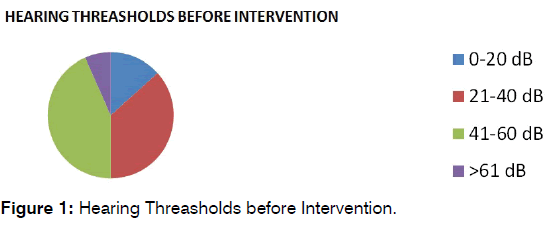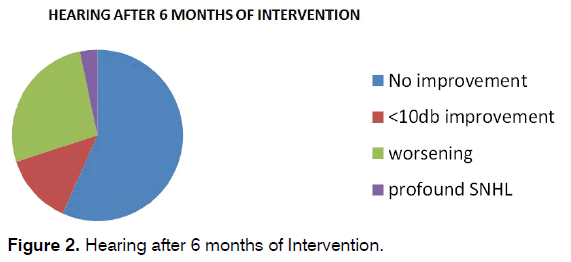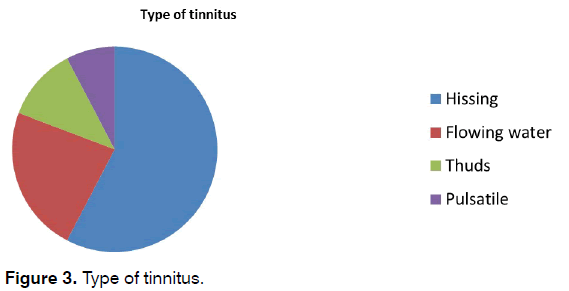The International Tinnitus Journal
Official Journal of the Neurootological and Equilibriometric Society
Official Journal of the Brazil Federal District Otorhinolaryngologist Society
ISSN: 0946-5448

Google scholar citation report
Citations : 12717
The International Tinnitus Journal received 12717 citations as per google scholar report
The International Tinnitus Journal peer review process verified at publons
Indexed In
- Excerpta Medica
- Scimago
- SCOPUS
- Publons
- EMBASE
- Google Scholar
- Euro Pub
- CAS Source Index (CASSI)
- Index Medicus
- Medline
- PubMed
- UGC
- EBSCO
Volume 21, Issue 1 / June 2017
Research Paper Pages:21-23
Short Term Results of Intra Tympanic Gentamicin and Dexamethasone on Hearing and Tinnitus in Meniere's disease: A Case Control Study
Authors: Irfan ul shamas
PDF
Abstract
Objective: The role of this study was to evaluate the effectiveness of intra tympanic administration of Gentamicin(40 mgs/ml) and Dexamethasone 0.5 ml(4 mgs/ml) on hearing and tinnitus of patients who had recurrent acute attacks of vertigo, tinnitus and hearing loss. Study Design: 60 consecutive patients of Meniere’s disease were randomly divided into 3 groups of twenty patients each. Group A included 20 patients who received intra tympanic gentamicin, Group B included 20 patients who received intra tympanic dexamethasone and Group C included 20 patients who received intra tympanic normal saline 0.5 ml. The mean pure tone thresholds at speech frequencies were noted before treatment and 2 weeks, 3 months and 6 months after treatment. Tinnitus was surveyed with a set questionnaire (Tinnitus Handicap Inventory). Results: The mean PTA at speech frequencies for Group A worsened from 50 dB to 62 dB which was statistically significant. Two ears developed profound sensorineural hearing loss. The mean tinnitus handicap inventory grade of group A was 4. Mean was 2 at the end of 6 months which indicates significant reduction of the tinnitus score. Group B patients had a mean PTA at speech frequencies of 42 dB. There was no gain in 12 patients and less than 10 dB in the remaining eight patients and no worsening of hearing was seen. The mean tinnitus handicap inventory grade in Group B was 2.5 and was 2 at 6 months after treatment. Group C patients had a mean PTA of 48 dB before treatment and were same after treatment however the tinnitus handicap grade was 2.5 before the treatment and 2.0 after treatment. Conclusion: Intra tympanic gentamicin is more effective in controlling tinnitus as compared to dexamethasone and placebo and there was no marked difference in control of tinnitus between placebo and steroids. There is significant hearing loss with IT Gentamicin and no marked difference between steroid and placebo on hearing.
Keywords: tinnitus, injections, vertigo, deafness
Introduction
Meniere’s disease is defined as recurrent attacks of spontaneous episodic vertigo,hearing loss,aural fullness and tinnitus(AAO-HNS) [1]. In 1861 Prosper Meniere first recognised that this disorder originated from inner ear but wrongly attributed it to haemmorhage [2]. In 1938 Hallpike and Yamakawa independently described a hydrops in endolymphatic system of patints with Meniere’s disease [2]. A number of different treatment modalities have been identified for this disease, ranging from dietery measures(e.g low salt diet) and medication (e.g betahistine, diuretics) to extensive surgery (e.g endolymphatic sac surgery). Although a large number of studies have been conducted on therapy for Meniere’s disease, an effective evidence based therapy has never been established [2]. Recently intra tympanic medications have gained widespread popularity [3]. It is worthwhile to conduct a first-hand study comparing the effect of gentamicin with dexamethasone.
Materials and Methods
The prospective study of 60 patients with Meniere’s disease (AAO-HNS criteria) was conducted in District Hospital Pulwama a secondary care hospital in Kashmir valley from February 2015 to August 2015. Patients with persistant symptoms despite maximal medical management were included in the study. All patients gave their informed consent before the procedure. Patients with tinnitus were graded using tinnitus handicap inventory before and after treatement. Patients with hearing loss underwent PTA before treatment and 2 weeks and 6 months post intra tympanic medication. Using a spinal needle 27 gauges and 2 ml syringe intratympanic administration of drugs was given in antero inferior quadrant of tympanic membrane with the head tilted to normal ear for 20 minutes. Gentamicin 2 ml (40 mgs/ml), dexamethasone 0.5 ml (4 mgs/ml) and normal saline 0.5 ml was administered.
Results
The average age of patients was 45 years with a male female ratio of 1:1.14. The mean PTA of the patients was 43.66 dB before any intervention was done (Figure 1).
PTA hearing improvement of equal or less than 10 dB was noticed in 8 patients. PTA hearing worsening was noted in 16 patients with two patients developing profound SNHL (Figure 2).
Out of the 60 patients in the study 52 patients had tinnitus. 30 patients described the tinnitus as low pitched hissing.12 patients described it close to the sound made by flowing water in a stream.6 described the tinnitus as loud thuds.4 patients had a pulsatile type of tinnitus (Figure 3).
Out of the 52 patients 32 patients responded after 6 months of intervention whereas 12 patients did not respond and had no change in tinnitus. There was worsening in 8 patients. 16 of the 20 patients of Group A responded and the mean THI was 4 prior to intervention and was 2 six months after the intervention which indicates a significant reduction. There was no significant reduction in tinnitus in Group B and Group C (Tables 1-2).
| Number | Responders | Non-responders | Worsening |
|---|---|---|---|
| 52 | 32 | 12 | 8 |
Table 1: Comparison of Tinnutus score change.
| Number | Group A(n=20) | Group B(n=20) | Group C(n=20) |
|---|---|---|---|
| 32 | 16 | 10 | 6 |
Table 2: Group wise change in tinnitus responder.
In our study the most common complication was temporary dizziness (n = 12). Tympanic membrane perforation occured in two patients which was subsequently managed with regular trichloroacetic acid cauterisation of the margins.
Discussion
Immunologic injury is implicated in many inner ear pathologies, and Meniere’s disease may be due in some cases to immune dysfunction. Immunologic or allergic causes of Meniere’s disease were proposed as early as the 1890s. In a recent study conducted by Tomoda et al3. 30 patients with classic Meniere’s disease underwent systemic and otologic investigations. Several cases showed hypergammaglobulinemia and antibody elevation to type 2 collagen in the serum and endolymph. Five of 18 patients (28%) were treated with oral prednisolone (60 mg/day). Hughes et al. also reported a good response in 20% of Menier’s patients treated with oral prednisolone [4]. Shea reported that Menier’s patients with acute rapidly progressive hearing loss have a marked response to oral dexamethasone [5]. Recently, intratympanic (IT) steroids have been used more widely due to lack of systemic side effects. IT steroids may have an anti-inflammatory effect in the labyrinth, as suggested by the beneficial response in inner ear diseases with likely immune causes [6]. In addition, recent in vitro studies suggest that steroid perfusion of labyrinthine tissues can affect sodium and fluid transport [7]. In our study there was some improvement in tinnitus with intra tympanic dexamethasone with no deterioration of hearing. So when hearing is to be preserved intra tympanic steroids may be used.
Gentamicin is an antibiotic which damages the inner ear and the balance organ when it is applied behind the ear drum. This treatment may decrease the spells of vertigo in Meniere’s disease. In a review of 50 patients conducted by Pullens et al. they found a beneficial effect of intra tympanic gentamicin therapy in Meniere’s disease [2]. Rodriguez et al. found a beneficial effect of intra tympanic gentamicin in controlling vertigo and tinnitus of patients with Meniere’s disease8. G W Hicks did a similar study and found that intra tympanic drug therapy i.e genatmicin and dexamethasone are both effective for controlling tinnitus [9]. Eklund et al. in their study of 93 patients of meniere’s disease found intra tympanic gentamicin produced significant improvement in tinnitus however produced significant deterioration in hearing [10].
Conclusion
Intra tympanic gentamicin therapy could be a simple and effective management option for controlling tinnitus however hearing loss is significant with IT gentamicin therapy. Intra tympanic steroids produce marginal improvement in tinnitus with no hearing loss. However further double blinded studies are needed to confirm the results.
References
- Faramarz M,Fatemeh H. Effect of intra tympanic dexamethasone on controlling tinnitus and hearing loss in Meniere’s Disease. Iran J Otorhinolaryngol. 2014;26(76):129-33.
- Pullen’s B, van benthem PP.Intratympanic gentamicin for Meniere’s disease or syndrome.Cochrane Database Syst Rev. 2011;16(3):CD008234..DOI:10.1002/14651858.CD008234.pub2.
- Tomoda K, Suzuka Y, Iwai H, YamashitaT, Kumazawa T. Meniere’s Diseaseand autoimmunity: clinical study and survey. Actaotolaryngol suppl.1993;500:31-4.
- Houghes GB, Kinner SE, Barna BP, Calabrese LH. Practical versus theoretical management of autoimmune inner ear disease. Laryngoscope. 1984;94(6):758-67.
- Shea JJ. Autoimmune sensorineural hearing loss as an aggravating factor in Menier’sDisease. Adv Otorhinolaryngol.1983;30:354-7.
- ParnesLS, Sun AH, Freeman DJ. Corticosteroid pharmacokinetics in the inner ear fluids: an animal study followed by clinical application. Laryngoscope. 1999;109:1-17.
- Pondugula SR, Sanneman JD, Wangemann P, Milhaud PG, Marcus DC. Glucocorticoids stimulate cation absorption by semicircular canal duct epithelium via epithelial sodium channel. Am J Physiol Renal Physiol. 2004;286(6):F1127-35.
- Verónica R, Perez-Garrigues H, Constantino M.Evaluation of two procedures of intratympanic gentamicin therapy in Meniere’s disease. Int. Adv. Otol. 2013; 9(1):82-8.
- Hicks GW.Intratympanic and round-window drug therapy: Effect on cochlear tinnitus. Int Tinnitus J.1998;4(2):144-7.
- Eklund S, Pyykko I, Aalto H, Ishizaki H, Vasama JA.Effect of intratympanic gentamicin on hearing and tinnitus in Meniere's disease. Am J Otol. 1999;20(3):350-6.
References
District Hospital Pulwama, Saderbal SrinagarKashmir JK India 190006, E-mail: drirfan007@gmail.com
Institution: District Hospital Pulwama
Send correspondence to: Irfan ul shamas District Hospital Pulwama, Saderbal SrinagarKashmir JK India 190006. E-mail: drirfan007@gmail.com
Paper submitted to the ITJ-EM (Editorial Manager System) on September 16, 2016; and accepted on January 27, 2017.
Citation: Shamas IU. Short Term Results of Intra Tympanic Gentamicin and Dexamethasone on Hearing and Tinnitus in Meniere’s disease: A Case Control Study. Int Tinnitus J. 2017;21(1): 21-23





